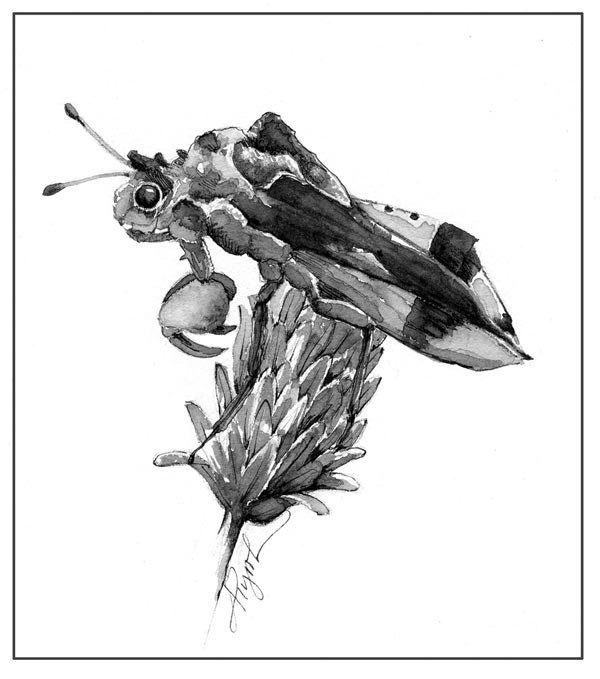
As a nature writer and photographer, I spend a lot of my time peering closely at leaves, twigs, and flowers, seeking what lurks in their midst. So it was that I discovered Phymata, the Ambush Bug. I was walking slowly through a meadow, bent over almost double as I carried a tripod-mounted camera instead of a magnifying glass. Spotting a fly on a daisy, I approached slowly, finding it odd that the insect didn’t move away from me. Puzzled, I looked closer and found a small, bulbous-eyed bug, his mouthparts embedded in the fly.
Ambush bugs lurk in the foliage, waiting for prey to come near. When they spot a victim they leap from cover, impale the hapless creature with a penetrating beak, pump liquefying enzyme into its body, and slurp up dinner. Although their specialty is disguise, their appearance, revealed, is daunting. If they were blown up to the size of a car, they would put a Bradley Fighting Vehicle to shame. Armored and massively muscular, they easily capture and overpower prey many times their own size. Of course, a little perspective is in order: this is a bug that could easily fit on the real estate of my smallest fingernail, with plenty of room to maneuver.
Dr. David Punzalan, a Postdoctoral Fellow at the Royal Ontario Museum’s Department of Natural History, has extensively researched ambush bugs. He explained that ambush bugs are “generalist predators” that take a wide variety of prey that typically visit flowers. Wasps, flies, and butterflies are all on the hit list. Ambush bugs will prey on insects that are considerably larger than themselves, including bumblebees.
I asked about their preferred hunting grounds. “The bugs don’t seem exceptionally picky about where they will hunt,” Punzalan noted, “as long as the insect traffic in the area is high.” Ambush bugs’ location varies over time, in keeping with what wildflowers are blooming. In late summer and fall, favorite host plants include Queen Anne's lace, goldenrod, thistle, asters, daisies, and black-eyed susans.
Following my exchange with Dr. Punzalan, I returned to the meadow and searched a bit more diligently for Phymata. Sure enough, I found them on a variety of flowers, many of them in the act of enjoying dinner. They’re beautiful: because of their angular shape they look almost prismatic, with colors ranging from emerald green to bicolored tan and gold.
In a subsequent email, Punzalan explained that some of the variation in color stems from sexual dimorphism (variations according to the sex of the organism), others from age. “Males are generally darker,” he noted, “with some dark patches reduced or absent in females.” This darker coloration appears to enable the males to better absorb heat energy from the sun, and thereby increase their mobility. Why this color differentiation exists between genders, however, is unclear.
In my second trip through the meadow, I had also noticed that on quite a few flowers, one ambush bug was perched atop another. “Piggybacking” is common, and symptomatic of the intense competition for females. This is not a mating behavior, but instead “mate-guarding” to prevent competing males from honing in on a chosen female. Males also engage in courtship behaviors that include twitching antennae, tapping forelegs, trembling pulses throughout their bodies, and rapid squeaking.
Squeaking? “Yes,” Punzalan confirmed. “Both sexes can stridulate by scraping their beaks on a file under their thorax. In fact, immatures appear to employ this technique when they’re alarmed. If you pick one up by the thorax and watch closely, you'll see rapid head-nodding which is the scraping movement, and if you hold them close to your ear you can even hear it.”
There are two species of ambush bug in the northeast, Phymata Americana and Phymata Pennsylvanica, although the nomenclature is a bit contentious. Some authors have placed the two as related sub-species, while others consider them to be altogether separate species in spite of the fact that there has been no formal demonstration of genetic or behavioral isolation.
Whatever the case, these are fascinating little creatures. Next time you’re out meadow-walking, take the time to look a little closer at the flowers that surround you. But beware: there are killers lurking.

